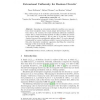Free Online Productivity Tools
i2Speak
i2Symbol
i2OCR
iTex2Img
iWeb2Print
iWeb2Shot
i2Type
iPdf2Split
iPdf2Merge
i2Bopomofo
i2Arabic
i2Style
i2Image
i2PDF
iLatex2Rtf
Sci2ools
CSL
2008
Springer
2008
Springer
Extensional Uniformity for Boolean Circuits
Abstract. Imposing an extensional uniformity condition on a non-uniform circuit complexity class C means simply intersecting C with a uniform class L. By contrast, the usual intensional uniformity conditions require that a resource-bounded machine be able to exhibit the circuits in the circuit family defining C. We say that (C, L) has the Uniformity Duality Property if the extensionally uniform class C L can be captured intensionally by means of adding so-called L-numerical predicates to the first-order descriptive complexity apparatus describing the connection language of the circuit family defining C. This paper exhibits positive instances and negative instances of the Uniformity Duality Property.
Automated Reasoning | CSL 2008 | Family Defining C | Uniformity Conditions | Uniformity Duality Property |
| Added | 19 Oct 2010 |
| Updated | 19 Oct 2010 |
| Type | Conference |
| Year | 2008 |
| Where | CSL |
| Authors | Pierre McKenzie, Michael Thomas, Heribert Vollmer |
Comments (0)

